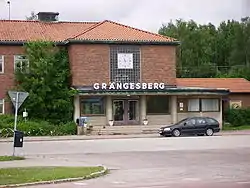Grängesberg
Grängesberg (Swedish pronunciation: [ˈɡrɛ̂ŋːɛsˌbærj])[2] is a locality situated in Ludvika Municipality, Dalarna County, Sweden with 3,481 inhabitants in 2010.[1]
Grängesberg | |
|---|---|
 Grängesberg Train Station | |
 Grängesberg  Grängesberg | |
| Coordinates: 60°05′N 14°59′E | |
| Country | Sweden |
| Province | Dalarna |
| County | Dalarna County |
| Municipality | Ludvika Municipality |
| Area | |
| • Total | 7.72 km2 (2.98 sq mi) |
| Population (31 December 2010)[1] | |
| • Total | 3,481 |
| • Density | 451/km2 (1,170/sq mi) |
| Time zone | UTC+1 (CET) |
| • Summer (DST) | UTC+2 (CEST) |
The town was earlier dominated by iron-ore extraction at Grängesberg ore field (Grängesbergs malmfält) from the 16th century to 1989.[3] In January 1990 was the last ore-train from Grängesberg to Oxelösund.
Grängesbergsbolaget had during a long period the world's largest iron-ore fleet and by 1899–1900 was it Sweden's most profitable company. During this time Grängesberg grew very fast, and during a 10-year period the town's population increased threefold. Today Spendrups is Grängesberg's biggest employer.
The area is famous of its Railway Museum of Grängesberg.
References
- "Tätorternas landareal, folkmängd och invånare per km2 2005 och 2010" (in Swedish). Statistics Sweden. 14 December 2011. Archived from the original on 10 January 2012. Retrieved 10 January 2012.
- Jöran Sahlgren; Gösta Bergman (1979). Svenska ortnamn med uttalsuppgifter (in Swedish). p. 9.
- Jonsson, Erik; Troll, Valentin R.; Högdahl, Karin; Harris, Chris; Weis, Franz; Nilsson, Katarina P.; Skelton, Alasdair (2013-04-10). "Magmatic origin of giant 'Kiruna-type' apatite-iron-oxide ores in Central Sweden". Scientific Reports. 3 (1): 1644. Bibcode:2013NatSR...3E1644J. doi:10.1038/srep01644. ISSN 2045-2322. PMC 3622134. PMID 23571605.
This article is issued from Wikipedia. The text is licensed under Creative Commons - Attribution - Sharealike. Additional terms may apply for the media files.
